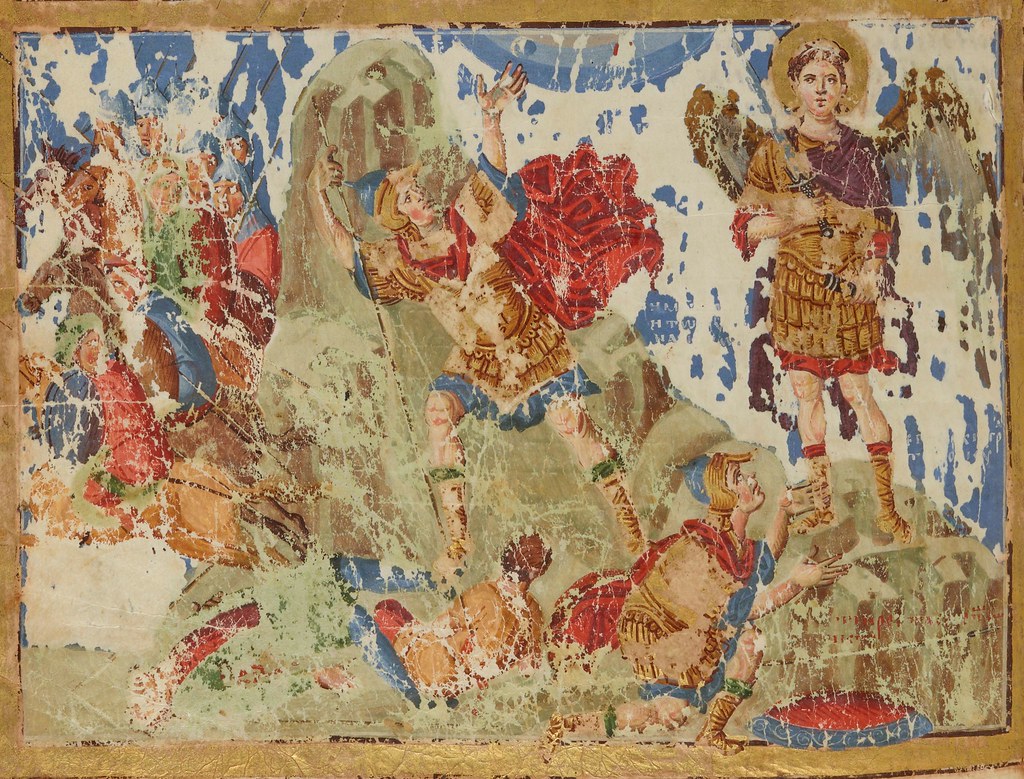f.226v. (lower register) Angel before Joshua
 A larger image of Angel before Joshua, f.226v, ‘Commentaries of Gregory of Nazianzus’, Byzantine, BnF Grec 510 |
 A larger image of Angel before Joshua, f.226v, ‘Commentaries of Gregory of Nazianzus’, Byzantine, BnF Grec 510 |
Titre : Grégoire de Nazianze, manuscrit dédié à l’empereur Basile Ier le Macédonien.
Date d’édition : 0879-0883
Type : manuscrit
Langue : Grec
Format : Parchemin. - 465 fol. - Onciale. - Peint. - 435 x 300 mm
Description : Grégoire de Nazianze, Homélies.
Source : Bibliothèque nationale de France, Département des manuscrits, Grec 510, f.226v
Miniature au folio 226v. Au registre inférieur, à gauche et au centre, Josué arrête le soleil et la lune (Josué 10, 12-14) : Josué (au centre) appuyé sur sa lance désigne de sa main gauche le soleil et la lune tandis que deux Amorites gisent à ses pieds et que d’autres (à gauche) fuient à cheval. Registre inférieur, partie droite, Josué et l’ange (Josué, 5, 13-15) : Josué s’agenouille devant l’ange qui est revêtu comme lui d’une cuirasse d’or et tient de sa droite une épée qu’il vient de tirer de son fourreau.
Miniature on folio 226v. In the lower register, left and centre, Joshua stops the sun and moon (Joshua 10: 12-14): Joshua (centre) leaning on his spear designates with his left hand the sun and the moon while two Amorites lie at his feet and others (left) flee on horseback. Lower register, right part, Joshua and the angel (Joshua 5: 13-15): Joshua kneels before the angel dressed like him in a gold breastplate and holds a sword in his right that he just drew from its sheath.
The upper register of f. 226v shows Moses striking water from a rock; the lower shows Joshua stopping the sun and moon, and Joshua confronted by the angel who is ‘the captain of the host of the Lord’ (Joshua 5:14). The first of the Joshua scenes shows the nimbless hero striding toward the left before a green mountain that provides a compositional pendant to the pink peak from which Moses draws water in the top register. Joshua’s right arm is raised to grasp the top of his lance, and his left follows his gaze as he turns back toward the sun and the moon, both encompassed by an arc of heaven, represented as concentric bands of blue at the top of the scene. Joshua’s cuirass is gold, as also are his leggings and the bottom of his helmet; its top, and the tunic under his armour, are blue; the fabric band protruding from beneath his shin guards is green. A red mantle, tied around his neck, blows out behind him and accentuates his turning movement. Two fallen Amorites lie beneath his feet; the rest of them flee on horseback toward the left. In his lack of a nimbus, the Gregory Joshua follows earlier precedents such as the mosaic at Sta Maria Maggiore and the Rabbula Gospels; these, however, omit the Amorites entirely and lack the arc enclosing the sun and moon. Most later examples, on the other hand, include the Amorites and the arc, but show Joshua nimbed. No other version duplicates Joshua’s stance.
In the second scene, Joshua, wearing the same costume and still nimbless, kneels and looks up at an angel who stands, blue sword in hand, on a small rocky outcrop that extends from the mountain of the first scene. The angel, like Joshua, wears military costume, with a gold cuirass and gold leggings; its undertunic and the material beneath its leggings are red, and its mantle purple. A red and blue shield, presumably Joshua’s lies in the foreground. While earlier versions of Joshua and the angel portray Joshua in civilian dress, later Byzantine examples follow f. 226v in presenting him as a military figure but, unlike Paris.gr.510, pictures Joshua twice, first standing (often before the city of Jericho), and then prostrate before the angel; also unlike f. 226v, in the later images Joshua usually looks at the ground rather than at the angel, and he is normally nimbed. In part because it presents a scene condensed to fit a limited space, the version on the east wall at Çavuşin (fig. 98) from the third quarter of the tenth century recalls f. 226v most closely: though Joshua appears twice, he looks up, and Jericho does not appear. The Cappadocian scene has been linked with a victorious military campaign, and this military flavour is anticipated on f. 226v.
Source: pp.193-194, Vision and Meaning in Ninth-Century Byzantium by Leslie Brubaker
Referenced as figure 202 in The military technology of classical Islam by D Nicolle
202A to 202D. Manuscript of St. Gregory Nazianzus, A - ‘Massacre of the Innocents,’ B - ‘Soldiers of Jaire,’ C - ‘Judgement of Solomon,’ D - ‘Angel before Joseph,’ c.880 AD, Byzantine, Bib. Nat. Ms. Grec. 510, ff. 137r, 170r, 215v and 226v, Paris (War).